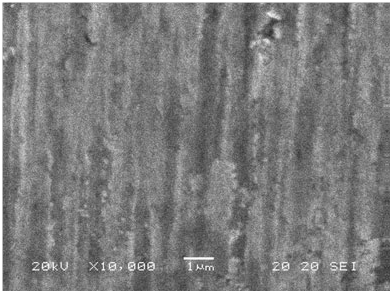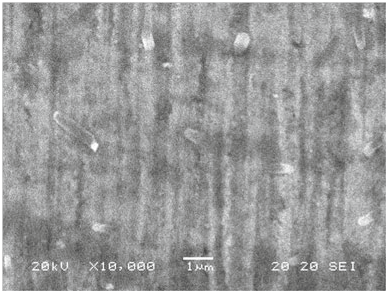Journal of
eISSN: 2572-8466


Research Article Volume 4 Issue 3
Department of Mechanical and Biomedical Engineering, City University of Hong Kong, Hong Kong
Correspondence: Kelvii Wei Guo, Department of Mechanical and Biomedical Engineering, City University of Hong Kong, Hong Kong
Received: July 24, 2017 | Published: November 30, 2017
Citation: Guo KW, Tam HY. Ti microholes potential for biomedical application punched by 75WC/25Co micropunch. J Appl Biotechnol Bioeng. 2017;4(3):572-576. DOI: 10.15406/jabb.2017.04.00102
Due to the trend of miniaturization, the specific advantages of metal forming, especially for the high productivity and the high material utilization, cannot be exploited to the same extent in the field of electronics production as in conventional metal forming. Because of this, the competition with less productive and environmentally more polluting technologies, such as chemical etching, increases.
Micropunching is extremely suitable for mass production of micro features, and the quality of the relevant punched microholes is definitely attraction to its successful application. Herein effect of cobalt on the morphology of microhole formed by punching with WC/Co micropunches was investigated. The morphology variation of the micropunched holes at different cobalt volumes were measured by scanning electron microscopy (SEM), energy dispersive spectrometer (EDS) and confocal laser. Results reveal that due to the optimal joint-contribution of WC and Co, the morphology of the microholes punched by micropunches with 75%WC+25% Co not only satisfies with the practical requirements, but also its using life is at the highest level among the three types of micropunches. Moreover, for 75WC/25Co micropunch, the serious wear of micropunch occurs with the wear loss of Co and WC both when the punching number exceeds 1525. With the punching numbers further increment, the dominant factors of the wear loss would mainly rely on the easily peeled off WC due to the serious loss of Co.
Keywords: microhole, WC/Co, micropunch, morphology, biomedical, lab-on-a-chip, EDS
In recent years, micro technology has become one of the key disciplines, having a significant effect on the development of new products and production technologies, as well as on the introduction of new methods for medical treatment and diagnostics. Moreover, due to the enormous potential for new applications, in future, micro technology will increasingly affect our daily life with an impact, comparable to that of the industrial revolution in the 19th century, or the development of information technologies in the 20th century.1-4
It is well known that microtechnology describes the technological approach, directed to the miniaturization of components and systems, down to micrometer scale. Major goals are the integration and increase of functionality in systems and devices, while keeping the dimensions small. Microtechnological components, such as distributed holes, bear the potential to provide further functionality, e.g. in sensor technologies or in biomedical applications. One prominent example is the lab-on-a-chip technology where the analytical functionality of the chip is given by specific functionalized surfaces.1,5
Up to now, the ever increasing demand for smaller, higher-quality and lower-priced products from almost all fields of industry, household equipment and entertainment electronics involves the optimization of already existing and the development of new manufacturing methods which are tailor-made for the micro systems technique with higher precision.1-6
However, these kinds of micro-devices are mainly made of silicone or glass, and fabricated by using micro-machining technique. Fabrication technology for providing the MEMS stably with low cost is one of the important issues.1,7
Therefore, the microholes formed by micropunching at low cost and in large quantities, applied for biomedical application, micro-parts fabrication and MEMS has been researched. This research aims at investigating the wear characteristics of 75WC/25Co micropunch (150μm in diameter) and the morphology variation of microholes formed by punching pure titanium (Ti) in various processing periods to overcome current problems in the micro-metal-forming technology. In the long run, this research can lead to making microholes distributed in the biomaterials (both non-metals and metals) at low cost and in large quantities with this eco-friendly technique.
Experimental material
Micropunch with 75 % volume fraction WC particle and 25 % volume fraction Co particle of 50μm mean size, 150μm in diameter, is shown in Figure 1. Figure 2 shows the surface texture of micropunch. Pure titanium sheet with 200μm in thickness was used as the substrate.
Experimental procedures
The prepared pure titanium sheet was properly cleaned by acetone and pure ethyl alcohol so as to remove any possible contaminant, and carefully put into the microdie. Thereafter, specimens were punched by the microprocessing machine MP50 (Made in Japan) with 20 pulses per minute, and feedrate of 2 mm.
The wear of the 75WC/25Co micropunch and the variation of the morphology of microholes in different processing periods were investigated using confocal microscopy, scanning electron microscopy, and energy dispersive spectrometer (EDS), and confocal laser.
Initial wear characteristic of 75WC/25Co micropunch
The relationship between the wear loss of 75WC/25Co micropunch and punching numbers is shown in Figure 3. It illustrates that the weight of micropunch (each for 5 times) has an obvious decrease with the increment of punching number in the initial. Its corresponding surface texture is expressed in Figure 4. It depicts that the particles distributed more uniformly than that of parent material (cf. Figure 2 & 4).
According to Figure 3 & 4, it shows that the wear of micropunch in the initial increases significantly, and WC particles cannot be easily observed. Consequently, the dominant factor of the wear loss in the initial period is mainly due to Co. The morphology of the formed microhole is expressed in Figure 5A. Some substrate debris is distributed sparsely in the backside as shown in Figure 5B, and its EDS results are illustrated in Figure 6.

Figure 4 Surface texture of 75WC/25Co micropunch in the initial condition (Punching number lower than 500).
Quasi stable wear characteristic of 75WC/25Co micropunch
After the obvious wear of 75WC/25Co micropunch in the initial, and with the punching number increasing, the wear of 75WC/25Co micropunch is in the quasi stable period with a little wear loss as shown in Figure 3, especially for punching number from 500 to 1200. Figure 7 illustrates its corresponding surface texture of 75WC/25Co micropunch. It shows small pieces of WC particles are observed on the surface. In the meantime, WC particles are distributed uniformly on the micropunch surface.

Figure 7 Surface texture of 75WC/25Co micropunch in the quasistable condition (Punching number between 500 and 1200).
The morphologies of the formed microhole are shown in Figure 8A. It illustrates that although there still distribute some substrate debris in the backside (Figure 8B), the profile of microhole formed in quasi stable period is definitely better than that of the initial period (cf. Figure 5 & 8). It reveals that due to the joint-contribution of WC and Co, the wear loss of micropunch in the quasi stable period is little.
Severe wear characteristic of 75WC/25Co micropunch
The surface texture of micropunch with punching number over 1525 is shown in Figure 9. It shows that large amounts of WC particles distributes on the micropunch surface because of serious wear loss of Co, which matches well with Figure 3. As a result, the wear of micropunch increases distinctly (Figure 3). Furthermore, with the punching numbers increasing further, the dominant factors of the wear loss would mainly rely on WC (which is easily peeled off during the micropunching) as shown in Figure 9. Meanwhile, the quality of the machined microhole decreases distinctly (cf. Figure 5,8,10 & 11). It illustrates that a large amount of micropunch materials are peeled off and adhered to the Ti substrate. At the same time, the substrate material could not be punched successfully and it would stick to the substrate. Also, with the effect of feed rate, the unsuccessful removed materials would be sheared and formed the larger debris as shown in Figure 11.
Profile of the microhole punched by 75WC/25Co micropunch
The diameter of the punched microhole by 75WC/25Co micropunch was measured by LEXT confocal laser-OLS3000 as shown in Figure 12. Its corresponding results (each for 5 times) are shown in Figure 13. Compared with Figure 3, it illustrates that in the different wear conditions the diameter of microhole is changed correspondingly. In the initial condition, the diameter of microhole decreases obviously with the increment of punching number, which definitely agrees well with results shown in Figure 3. While the punching number is from 500 to 1200, the diameter of microhole is relatively kept stable. With the punching number increasing further, especially when the punching number exceeds 1525 as shown in Figure 13, the diameter of microhole decreases remarkably because of the serious loss of Co. Consequently, the serious wear of micropunch mainly relies on WC particles which are easily peeled off without Co as bonding material in the severe wear condition of micropunching. Meanwhile, due to the temperature increment with punching number increasing, WC particles are more easily peeled off resulted in more intensive wear loss. Moreover, if the pulses per minute increases, the wear loss of micropunch will be more drastically. In addition to the abovementioned, the microstructure of micropunch should be considered further, especially for the distribution of WC and Co particles.
The wear characteristic of the WC/Co micropunch used for micromachining microhole potential for biomedical application had been researched. It shows that the wear of micropunch increases significantly in the initial, and the dominant factor of the wear loss mainly rely on Co. With the increment of punching numbers, the wear of WC/Co micropunch is in the quasi stable period with a little wear loss. However, when the punching number exceeds 1525, the serious wear of micropunch occurs with the wear loss of Co and WC both. Moreover, with the punching numbers further increment, the dominant factors of the wear loss would mainly rely on the easily peeled off WC. Meanwhile, the quality of microhole decreases intensively.
The work is supported by the Strategic Research Grant (SRG) from City University of Hong Kong (Grant No.: 7004598).
The author declares no conflict of interest.

©2017 Guo, et al. This is an open access article distributed under the terms of the, which permits unrestricted use, distribution, and build upon your work non-commercially.